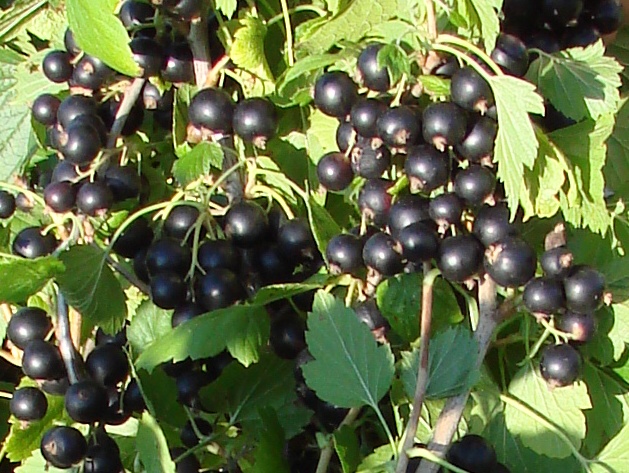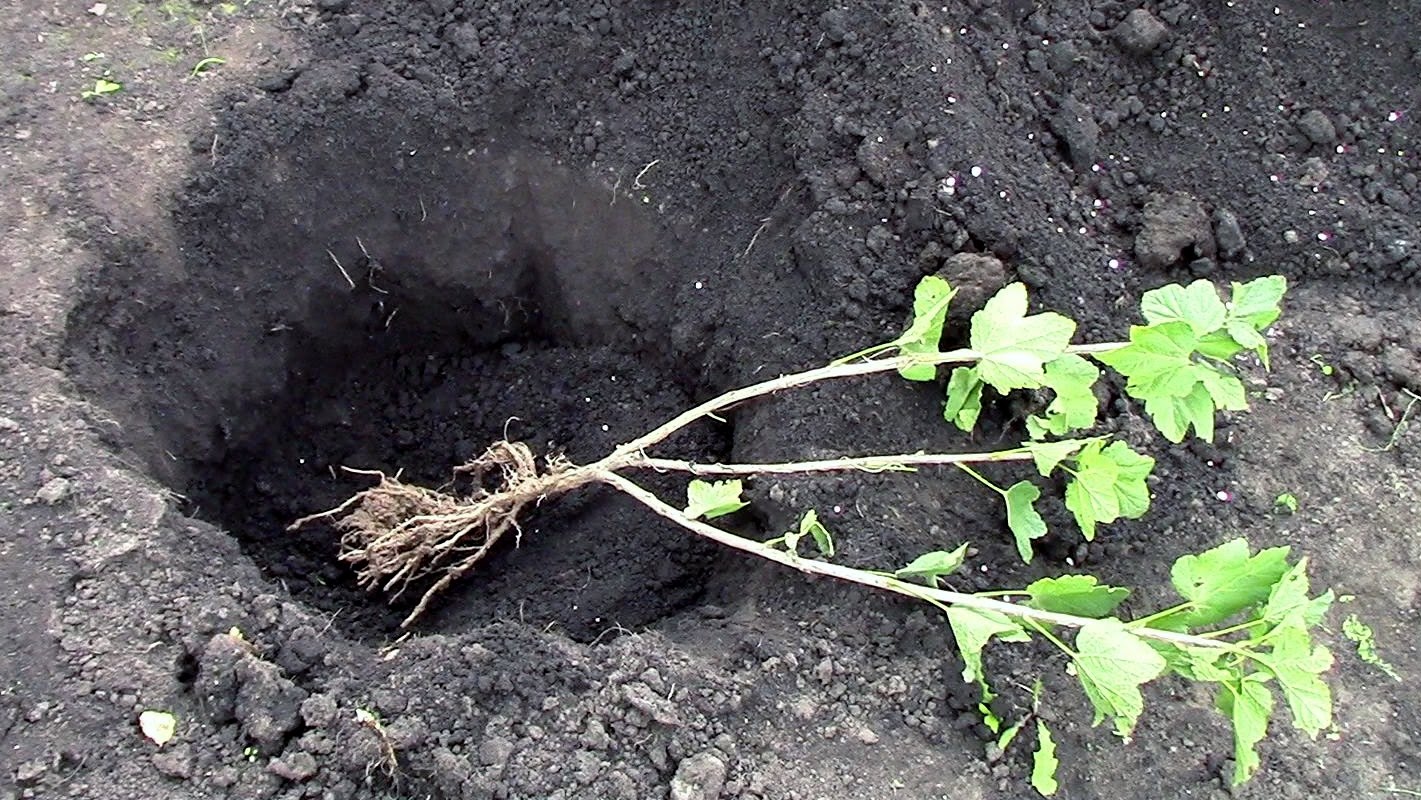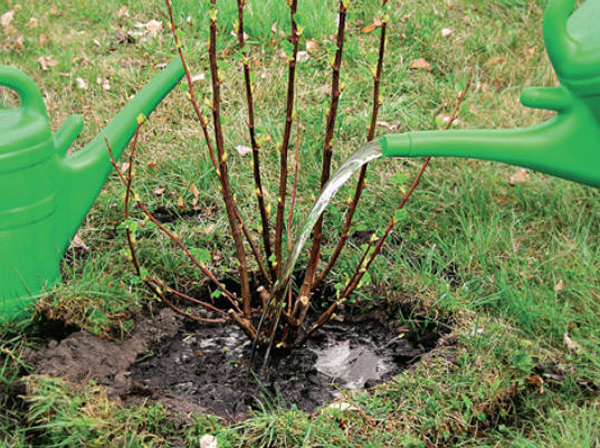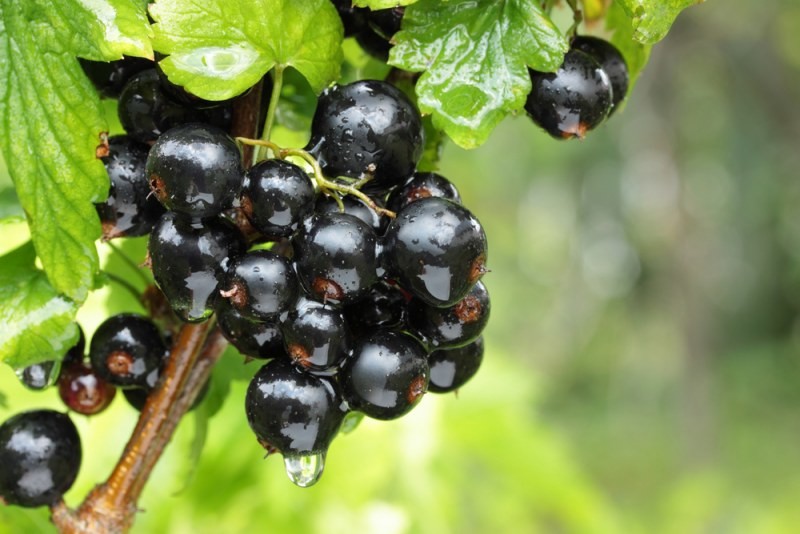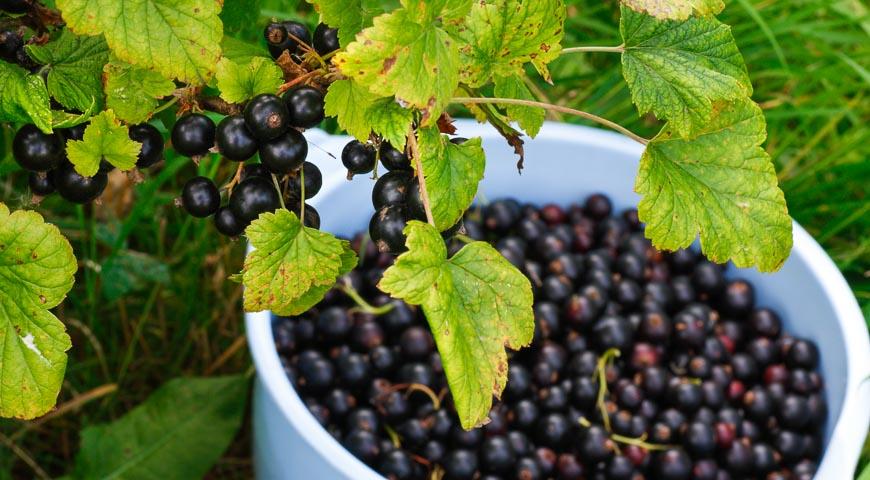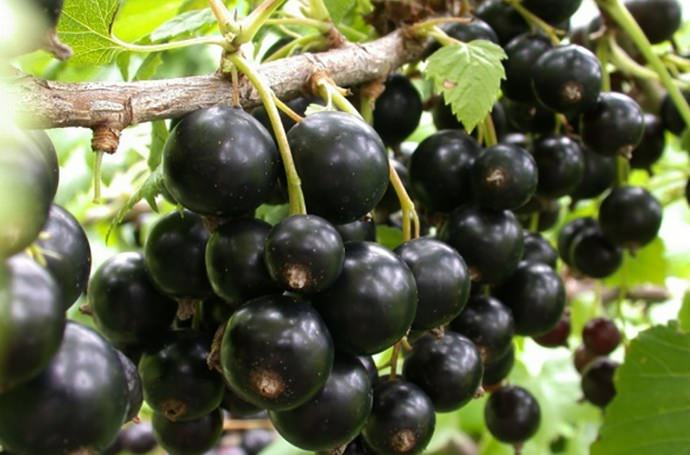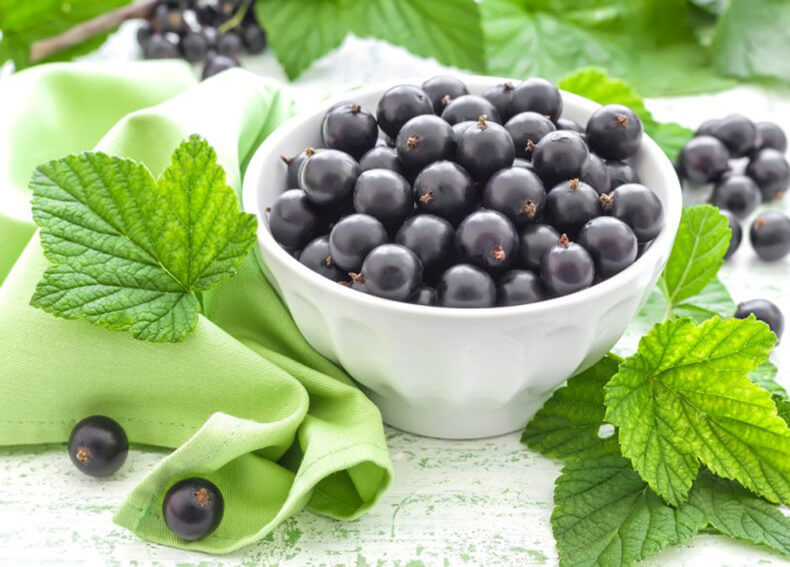Content:
Currant is a berry shrub, which is often found in summer cottages and backyards. Among the variety of species of this culture (more than 190), the most popular are red and black currants. It is the latter type that will be discussed in this article.
Features of culture
Black currant is a shrub with a height of 0.5 to 1.5-2.0 m, consisting of 5-10 erect or slightly spreading shoots, covered with large single 3-5 lobed leaves, pale green on top and rich green and covered villi from below. Small flowers are collected in drooping brushes. Currants bloom from late April to late June. The fruit is a juicy berry, up to 10 mm in diameter. In a mature state, it has an inky black color, sour, sweet and sour, sweetish or sweet taste.
In addition to the bush forms of this culture, there is also such a variety as the columnar currant. It represents erect, powerful and very tall shoots growing in the form of a cylindrical column.
Common varieties of black currant
According to many experienced gardeners and summer residents, the best varieties of black currant are the following:
- Litvinovskaya is a variety of medium early ripeness. It is characterized by a powerful and compact bush, consisting of erect, high (up to 1.2-1.5 meters) stems. The variety has high winter hardiness, is not damaged by spring frosts, is resistant to fungal diseases, kidney mites. The yield from 1 bush can reach 2-2.5 kg of large berries, in the taste of which there is a pleasant and delicate sweetness;
- Smolyaninova's gift is an early variety with a spreading, medium-high bush. The berries are large, deep black in color with a characteristic gloss, sweet dessert taste and unique aroma. The variety is resistant to fungal diseases, kidney mite damage. The yield from 1 bush is from 2-2.5 to 3.0 kg. It has an average winter hardiness and resistance to early spring frosts;
- Selechanskaya 2 is a large-fruited, productive variety of early ripening. It has an erect, powerful and large bush, up to 1.5-2.0 m high. The berries are large, dark black in color with a glossy surface, they ripen together, stick well to the bush and do not crumble even in an overripe state. The variety is resistant to diseases such as powdery mildew, anthracnose; poorly populated by kidney mites. It has high winter hardiness, withstands prolonged drought. The yield of 1 bush is achieved with proper care of 6-8 kg;
- Summer resident is a low-growing variety, with sprawling shoots that often touch the ground. Sweet, with a strong aroma, berries are of medium size, oval, blue-black color with a matte surface. Productivity from 1 bush with proper care is up to 4-5 kg. The variety is resistant to powdery mildew, practically not colonized by kidney mites;
- Dobrynya is a mid-season variety with low compact bushes. The stems often come into contact with the ground under the weight of the crop. The berry is large, slightly oval, deep black in color, with a glossy (shiny) surface, has a characteristic sour taste. The variety has high winter hardiness, high and medium resistance to powdery mildew and kidney mites, respectively. The yield from 1 bush reaches 2.0-2.5 kg;
- Bummer is a late-ripening variety with a high (up to 2 m), powerful and spreading bush.The berry has a black color with a brown tint, a rounded shape and a sweet taste with a slight sourness. Winter-hardy, weakly affected by anthracnose, double leaves; has medium resistance to kidney mites. The average productivity of 1 bush is 1.0-1.2 kg.
Other popular blackcurrant varieties
| Variety name | Early maturity |
|---|---|
| Pigeon | Ultra early |
| Minx | |
| Musketeer | |
| Nightingale night | |
| Tisel | |
| Ruslan | |
| Nestor Kozin | Early ripe |
| Curiosity | |
| Llama | |
| Nika | |
| Orlovia | |
| Sweetheart | |
| Black veil | |
| Eye of the Dragon | |
| Gulliver | |
| Detskoselskaya | |
| The little Prince | |
| Gratifying | |
| In memory of Shukshin | |
| Gift to Kuzior | |
| Sevchanka | |
| Selechanskaya | |
| Constellation | |
| Exotic | |
| Cherry | |
| Gamma | Medium early |
| Ruben | |
| Tsema | |
| Ariadne | |
| Sensei | |
| Sibylla | |
| Openwork | |
| Fidelity | Mid-season |
| Lucia | |
| Hope | |
| Unexpected | |
| Nyursinka | |
| In memory of Kukharsky | |
| Prestige | |
| Sadko | |
| Sanuta | |
| Tiben | |
| Lovely sight | |
| Sorcerer | |
| Black BMW | |
| Extreme | |
| Grace | |
| Kudmig | |
| Monisto | |
| Wonderful moment | |
| Gama | |
| Kola Souvenir | |
| Ksyusha | |
| Llama | |
| Mila | |
| Minai Shmyrev | |
| Minusinskaya sweet | |
| Minusinsk steppe | |
| Muryuchana | |
| Incomparable | |
| Ojebin | |
| Necklace | |
| Charm | |
| In memory of Potapenko | |
| Memory of Vavilov | |
| Memory Lisavenko | |
| Perun | |
| Petersburg woman | |
| Pygmy | |
| Bow to Borisova | |
| Poetry | |
| Rita | |
| Northern Lights | |
| Slav | |
| Treasure | |
| Sophia | |
| Oryol Serenade | |
| Sudarushka | |
| Enchantress | |
| The dark woman | |
| Black stork | |
| Black Pearl | |
| Spherical | |
| Izmailovskaya | |
| Karaidel | Medium |
| Romance | |
| Triton | |
| Ben Lomond | |
| Dense | |
| Ilyina's gift | |
| Mermaid | |
| An ordinary miracle | |
| Tatyana's Day | |
| Chernavka | |
| Vigorous | |
| Jubilee digging | |
| Sofievskaya | |
| Bagheera | |
| Venus | Late ripening |
| Harmony | |
| Fortune | |
| Kipiana | |
| Mulatto | |
| Natasha | |
| Oryol Waltz | |
| In memory of Bredov | |
| Pauline | |
| Cerra | |
| Nora | Very late |
| Gift to October |
Among the varieties of red currants, the following are most popular:
- Alpha;
- Assora;
- Leader;
- Fertody;
- Ural dawns;
- Chulkovskaya;
- Generous;
- Oryol Star;
- Ruby;
- Rudneus;
- Stefania is red;
- Valentinovka;
- Dana;
- Commemorative;
- Memory of Gubenko;
- Ural souvenir.
Of the varieties of white currant, the following are popular:
- Tsarskaya;
- Belyana;
- Versailles white.
Found on personal plots and pink currants (Pink Pearl, Jumping, Rosa Chair, Lyubava).
Planting black currant
Planting, both individual bushes and the whole plantation, is carried out as follows:
- A high and well-lit place with light and fertile soil is chosen on the site;
- The site is plowed in advance (in the fall), bringing in 4-6 kg of rotted manure or humus;
- At the chosen place in early spring, when the soil dries up, trenches are made, 40-60 cm wide and 30-40 cm deep.A mixture of humus and mineral (phosphorus and potash) fertilizers is applied at the bottom of the trenches in an even layer per 1 square meter: double superphosphate - 100 g, potassium sulfate - 40 g, humus - 10-12 kg.
- The seedling in the trench is placed at an angle of 450 and, having sprinkled its root system with soil, carefully compact it;
- The distance between seedlings in a row should be at least 1.0-1.2 m; between two adjacent rows –1.5-2.0 m;
- When planting in dry soil, the seedlings are thoroughly watered with settled warm rainwater.
Care and reproduction rules
Care
Growing black currants in the conditions of summer cottages and backyards provides for careful care of the bushes, consisting of such operations as:
- Top dressing - 2-4 dressings are performed during the season. The most optimal time for the first feeding is early spring, when the buds begin to swell on the shoots. Add dry nitrogen fertilizers in the form of urea (50-60 g / bush) or ammonium nitrate (60-65 g / bush), distributing them evenly over the soil near the bush and sprinkling with mulch. The following spring dressings are carried out with an interval of 12-14 days with organic fertilizers (humus at a dose of 10-12 kg / bush or an infusion of mullein dissolved in water in a ratio of 1: 5 - 5-6 l / bush). Summer dressings are made with organic fertilizers (mullein infusion, humus) in the phase of filling and ripening of berries. Starting from 4 years old, the bushes in the fall are fed with potash and phosphorus fertilizers at a dose of 50-55 g / potassium sulfate bush, 80-90 g / double superphosphate bush;
- Loosening and mulching the space around the bushes - this technique is performed in early spring, simultaneously with feeding, embedding fertilizer granules into the soil. The row spacings are loosened to a depth of 10-12 cm, the soil near the bushes is very carefully, to a depth of no more than 5-7 cm. Humus, rotted manure, low-lying peat are used as mulch. The mulch layer should be at least 5-8 cm;
- Watering - done as the top layer of the soil dries up, as well as in the phase of flowering, filling and ripening of berries. Watered gently, at the root, with warm settled rainwater. The average rate of water consumption per 1 bush is 8-10 liters. Watering is carried out in the late evening;
- Pest and disease control - includes spraying plants against pests (currant bud mites, aphids, moths) and diseases (anthracnose, powdery mildew, septoria, rust, gray rot). For pest control, insecticides such as Karate-Zeon, Kinimiks, Fufanon, Aktelik are used. Such fungicides as Topaz, Fundazol, Topsin-M suppress or completely destroy pathogens. For the prevention of diseases and pests, fallen leaves are removed from under the bushes every autumn and the soil is loosened to the permissible depth. This is done because the causative agent of the disease, the pest (more precisely, its larva) can winter on the foliage and in the soil;
- Pruning - done in early spring and fall. In the spring, shoots damaged by frost and rodents, thickening the bush, are removed. In the fall, unripe, disease-damaged and intertwined shoots are cut out. In both spring and autumn pruning, the shoots are cut with a sharp pruner as close to the soil surface as possible.
Reproduction
Every seasoned gardener knows that black currants are propagated in 2 ways:
- Cuttings - for this, during spring pruning, one-year-old light-yellow growths are selected from remote shoots with buds that have begun to swell and cuttings are cut from them, 15-20 cm long.In this case, such a cutting should have a lower oblique cut of 5-7 mm under the bud and upper straight line 10 mm above the kidney. Cuttings prepared in this way are planted obliquely (at an angle of 40-450) into the prepared and fertilized soil of the garden, while leaving no more than 2 buds above the ground. The distance between the cuttings in a row with such a planting should be 10-12 cm, the row spacing should be 35-40 cm. A strip of plastic film, a small layer of humus - this is the mulch with which the aisles and the space between the planted cuttings are covered. During the summer, as the leaves appear, the cuttings are abundantly sprayed with warm water. Well-rooted cuttings can be transplanted in late summer or early spring. It is recommended to insulate such a school for the winter;
- Layers - well-developed and annual shoots in early spring bend away from the main bush and, sprinkling with earth in the middle, press the resulting embankment with a stone or brick. From such a layering during the warm season, a full-fledged seedling with its own root system is obtained.To transplant it to a permanent place, the load is removed, the embankment above the layering is carefully excavated and, with the help of a pruner, the layering is cut off from the mother bush. In this way, a new plant with a good root system and stem is obtained without special costs.
A properly grown bush of this culture will delight the zealous owner with a rich and useful harvest.
Currant is useful for the human body in many ways: it reduces pressure, improves the condition of blood vessels, accelerates the process of urination, eliminates disorders of the digestive tract, promotes mental activity, has an anti-inflammatory effect, helps to lower blood sugar, under the action of the substances contained in the berry, the skin is smoothed, moisturizes.
The main contraindication for the use of this berry is a disease such as thrombophlebitis. It is not recommended to use currants for people who have increased stomach acidity.
